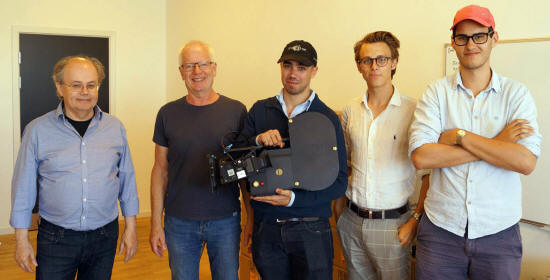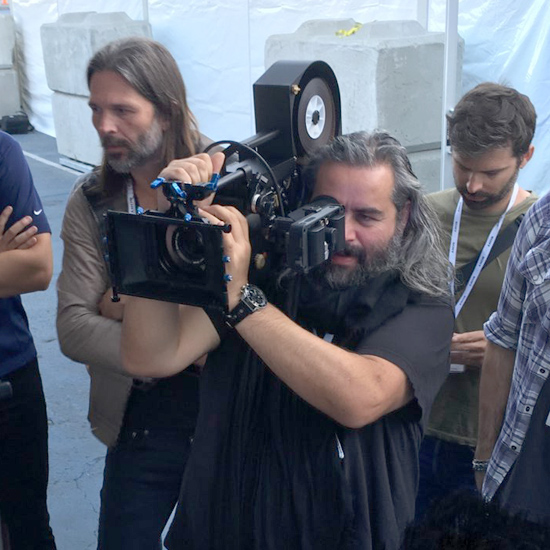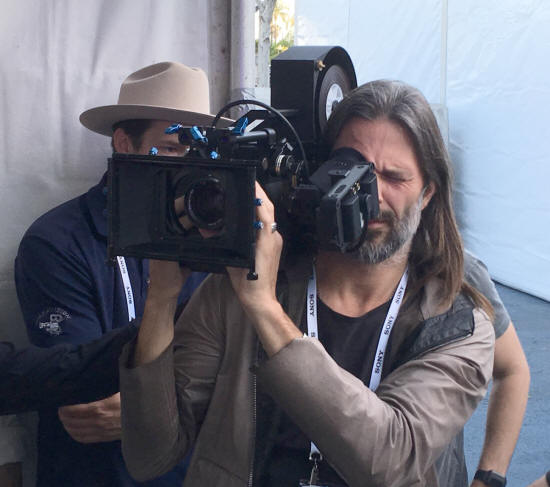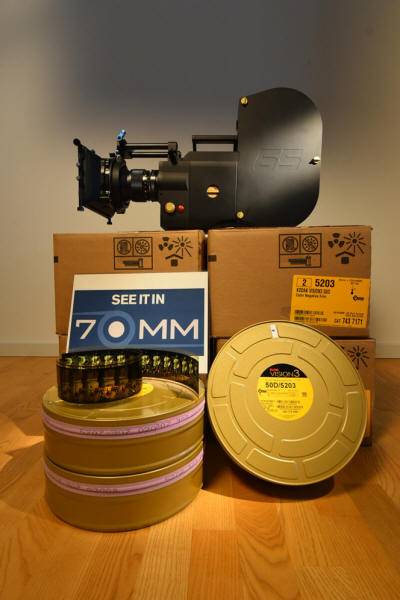From Frederikshavn to Hollywood |
Read more at in70mm.com The 70mm Newsletter |
| Written by: Steen Dalin, Dansk Filmfotograf Forbund. | Date: 16.02.2019 |
 The
news about Magellan 65 have created attention from Hollywood to
Frederikshavn. Seen here with Danish cinematographer Ben Brahem Ziryab
(with the Magellan 65) and (from left) Tommy Madsen, Orla Nielsen, Ben,
producer William Lindhardt and director Simon Wasiolek.
Picture: Ben Brahem Ziryab The
news about Magellan 65 have created attention from Hollywood to
Frederikshavn. Seen here with Danish cinematographer Ben Brahem Ziryab
(with the Magellan 65) and (from left) Tommy Madsen, Orla Nielsen, Ben,
producer William Lindhardt and director Simon Wasiolek.
Picture: Ben Brahem ZiryabAn Ominous Prologe Timing is everything. That makes me recall a personal example of bad timing. Through the 90’s Casper Høyberg and I worked on model animation/puppet movies. We tumbled around with heavy, clumsy Mitchell cameras, which were the ultimate tool of that period. Why was that, we thought, when animation only needed a series of single images, whose overall duration rarely exceeded 10 seconds? Why not use a still image camera? On the second Indiana Jones movie Spielberg had, without any problems, used a common Nikon (equipped with 30 metre magazine and Oxberry registration pin) for stopmotion sequences featuring ‘Indy’ and co. as doll models in tippers running along in a rollercoaster-like hunt. Of course he had the advantage that he and George Lucas had already reinvented Vistavision with a horizontal filmstrip in a 24x36mm format. Our 35mm film ran vertically and took up half as much space. My very first camera as a teenager was an upright half format 18x24 with 72 pictures in a roll - so why not revive the format? A Polish engineer, who helped us equip the Mitchells with single-image-motors, was ecstatic about the idea. On his own initiative he put the Technical University of Denmark to work on the project and used half of his family’s fortune on it. But alas, when the prototype was ready, the industry had moved to the digital platforms. As a summer substitute at Egmont Imagination, who extraordinarily produced commercial animation for England, I experienced with my own eyes the development through three years: We started out with Mitchell, the year after that it was useless video-frame-grab systems and the last summer, before Egmont completely dismantled the animation at Mejeriet Friheden, stop-motion had, in just a few years, gone digital with common and cheap SLR cameras. We had a revolutionary stop-motion camera at the worst possible time. Back to the Future However, it looks like the trefoil behind Logmar Camera Solutions have the perfect timing, as they unveiled a brand new 65mm handheld camera in April, which was displayed at Cine Gear in Los Angeles a couple of months later. And quite luckily it coincided with an intense focus on large format at Cine Gear 2018. It did not last long before cinematographer-stars such as Linus Sandgren ("La La Land" & "First Man") and Hoyte van Hoytema (“Interstellar” & "Dunkirk") found their way to Logmar’s exhibition stand. |
Læs mere her: The Magellan 65 receives Technical & Scientific Achievement Award Designing the Magellan 65 Camera A new hand-held 65mm Camera Internet link: Tommy Madsen & Phil Vigeant from Pro8mm demonstrates Chatham Test with Chatham Super 8 |
 Hoyte van Hoytema FSF NSC ASC with the
Magellan 65mm camera on his shoulder. Picture:
Orla Nielsen Hoyte van Hoytema FSF NSC ASC with the
Magellan 65mm camera on his shoulder. Picture:
Orla NielsenThey have both been nominated for Academy Awards and have great experience in 65mm (and are both members of the Swedish Society of Cinematographers, one might add). Along with other participants at the International Cinematography Summit, they showed great interest in a wide format camera of such small dimensions, with a total weight of just 12 kilograms including 122 meters of film. • Go to Designing the Magellan 65 Camera • Go to A new hand-held 65mm Camera But how is a so advanced machine born in such anonymity, and from a grain silo on a dock in the small coastal town Frederikshavn of all places? It all starts in 2014, when Tommy Lau Madsen retires. As a mechanical engineer he has, among others things, worked for the Aarhus-based lighting company Martin Professional, and now he suddenly has time to cultivate a passion he has had since early childhood: FILM! Not the digital kind but the good old celluloid. He starts off small and begins working on the idea of creating the perfect Super 8 camera. The camera is designed at his kitchen table and Tommy is systematic in his approach. First he has to learn to operate a 3D CAD software on his computer. After that, he buys a 3D-printer so he can make sure the individual pieces fit together in different trial setups. As for the electronic part, he is aided by an Italian living in Switzerland, Rodolfo Zitellini, who is now permanently affiliated to the firm. Tommy’s camera doesn’t look like a classic Super 8 camera: There is no optical viewfinder, but instead just a view-finder screen that is folded out, as on a digital camera. Inside the construction, a small electronic camera reads off a ground glass, which receives its image from a mirror on a super light-weight guillotine-shutter. The built-in plastic pressure plate of the Kodak cassette has been dropped. Instead the film is looped around a sprocketwheel and from there into the camera’s own pressure plate and filmport - which, by the way, has been widened so the format is more similar to the present’s 16x9 format. During exposure, a registration pin ensures optimal picture steadiness, just as on traditional professional 16 and 35mm cameras. However, until now this was unprecedented in the history of 8mm strips. On top of that comes built-in Wi-fi and a digital sound recorder. Voilà! The world’s first (and best) modern Super 8 camera has been created since VHS eradicated “narrow format” more than 30 years ago. In 2014, 50 cameras are produced, although Tommy does not possess actual production facilities. The individual pieces are produced at a machine shop in Dragør, which also produces camera houses for the medium format camera Phase One. Fitting, adjustments, as well as miscellaneous tests are done by Tommy in majestic solitude. However, distribution and sales are established in collaboration with a company in Los Angeles. Pro8mm is a small business in Burbank, which has specialised in everything to do with Super 8. For years, they have been renovating and rebuilding old Beaulieu and Bolex cameras, to a degree in which they appear better than when they originally left the factory. Moreover they develop super 8 and digitalize all formats in an extensive program. But that is not all. To accommodate the growing revival of the format, they have developed equipment to slice up 35mm film into 8mm strips. These can then be perforated and put into cassettes, so the entire program becomes available from Kodak. Positives as well as negatives. |
|
 Linus Sandgren FSF tries out the Magellan 65mm by the Paramount stand at Cine
Gear 2018. Picture by Orla Nielsen Linus Sandgren FSF tries out the Magellan 65mm by the Paramount stand at Cine
Gear 2018. Picture by Orla NielsenThe Empire Strikes back At this time, the last man in the triumvirate enters. Orla Nielsen DFF takes on the responsibility of test shootings and the execution of a vigorous testing scheme. The reason being that a well known player has announced its arrival. Kodak has been inspired by Logmar and has decided to make their own new camera.
During the process of working with the Super 8
camera, Tommy and Orla acquires a vast number of international contacts with
professional players. They have changed Logmar’s address from Tommy’s kitchen
table to a new office in the restored Kattegat Silo at the docks in
Frederikshavn and in Tommy’s mind a new projects begins to take shape.
The minimal weight and the small dimensions of
the Magellan camera is due to the new features, which have been upscaled from
the Super 8 camera to 65mm. |
|
 Orla
Nielsen: “We found out, that we were virtually
alone on the market".
Picture: Thomas Hauerslev. Orla
Nielsen: “We found out, that we were virtually
alone on the market".
Picture: Thomas Hauerslev.Instead of the traditional rotating mirror, the camera is equipped with a guillotine shutter, which saves both weight and volume. The shutters high-responsive mirror creates an image on the ground glass, that via a diminutive Sony camera ends up on the camera’s fold out screen - or is sent by wi-fi to any monitor or smart phone. Hereby, there is always a well-defined image available in high resolution, regardless of light conditions or aperture. And of course the camera can be remote-controlled, no matter if it is sitting on a crane or the wing of an airplane. The electronics also control frame rates of 2 -54 f/s. and provide information on film usage. And in this article in a cinematographic journal, we have not even touched upon the built-in sound part with 5 pin XLR. The choice of lens mount was the subject of much scrutiny. In the end the entire series of optics for Hasselblad 500CM was chosen. Besides being a standard item at an affordable cost, these magnificent Carl Zeiss optics precisely covers a 65mm image. Arri and other mounts can be installed without problems. The machine shop in Dragør is still the supplier but for the new camera a company from Sønderborg have also been involved. Definitely a 100% Danish-produced camera. So far the two businesses have delivered the parts for five cameras, which are being assembled, tried and exposed to comprehensive test-setups in Frederikshavn. The previous collaboration with Kodak resulted in the film manufacturer being an active part of the process with the 65mm camera and they have also been very helpful with raw stock and film stock development. It has not been decided whether the camera is to be offered up for sale or if it will be rented out through the different rental houses across the world. Much speaks for the latter option, as such an advanced camera is expected only to be used in top-tier productions and because of that requires massive maintenance. You do not send a Formula 1 car out on the track without several pit stops. The camera is still being developed. Among other things, it has turned out that the panel on the right side of the camera can be difficult to operate. So, effort is being put in to replace it with a much larger touch screen, which will be directly connected to the powerful NVIDIA computer, which serves as the heart of the camera’s electronic control. But since Magellan saw the light of day in April this year, and well before the presentation at Cine Gear in Los Angeles, there have been talks of a functioning camera.
Orla Nielsen says.
So the future seems bright for the first
serious camera in Denmark since the carpenter J. P. Andersen (also known as the
Nellerød-man) created his handmade cameras out of Cubamahogni in the previous
century. I wonder if this is not for once a case of extraordinarily good timing? |
|
|
Names If you have wondered about the use of names, Orla Nielsen informs us that Tommy’s family always had a soft spot for penguins and the cameras had to have some name. Well chosen, one might add, as the Chatham penguin became extinct in 1872 (just as the Super 8 camera is no longer in production). A little less well chosen is the Magellan penguin that is only endangered, however still surviving in colonies in Argentina, Chile and the Falklands. Logmar is said to be an old nordic name but I have not been able to track down the origin. Editor: Steen Dalin Translated by: Joachim Ulvedal Photos: Orla Nielsen, Thomas Hauerslev, Steen Dalin - Layout: Maria Mac Dalland Proof-reading (Danish): Eva Hammershøy A thank you to Torben Glarbo |
|
| Go: back - top - back issues - news index Updated 22-01-25 |
